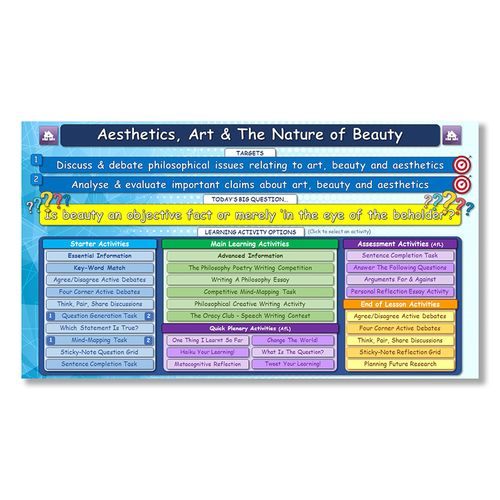










This fun philosophy lesson focuses on aesthetics, art and the nature of beauty. Aestheticians ask questions like “What is a work of art?”, “What makes a work of art successful?”, “Why do we find certain things beautiful?”, “How can things of very different categories be considered equally beautiful?”, “Is there a connection between art and morality?”, “Can art be a vehicle of truth?”, “Are aesthetic judgments objective statements or purely subjective expressions of personal attitudes?”, “Can aesthetic judgments be improved or trained?”
This session is of particular interest to Art Teachers and teachers of subjects that have an aesthetic component (such as Design, Crafts, and Textiles); we’ve carefully selected the most significant philosophical issues wrestled with by aestheticians both ancient and modern so that young learners can engage in fun philosophical discussions and debates. This session explores topics such as:
- The nature and value of art
- Different ways of evaluating art
- The nature of beauty and the degree to which it is “in the eye of the beholder”
- Cultural and historical relativism in evaluating art and beauty
- The impact of AI in the creation of art
The big question asked in this session is “Is beauty an objective fact or merely ‘in the eye of the beholder’?”. Using a variety of engaging activities students will discuss and debate a wide range of other philosophical questions such as:
- What makes one object “art” and another object “not art”?
- How should we measure the value of art?
- Why do people create art?
- What are the moral duties of an artist?
- How can creating art benefit our community and society?
This resource is suitable for students aged 8-16; due to the flexible nature of the sessions design it can be used for multiple hour-long sessions or as a short stimulating tutor-group activity.
The file is a PowerPoint Show: no planning or preparation is required, just run the file and the intuitive menu system will make delivering a powerful philosophy session very easy!
This session uses our unique format for philosophy teaching resources and features an integrated menu that allows teachers to select from a variety of starter, main, plenary, assessment and end-of-lesson reflection activities. With a massive selection of activities designed to trigger philosophical discussions, debates and reflections: you can re-use the resource numerous times with the same group.
Something went wrong, please try again later.
This resource hasn't been reviewed yet
To ensure quality for our reviews, only customers who have purchased this resource can review it
Report this resourceto let us know if it violates our terms and conditions.
Our customer service team will review your report and will be in touch.